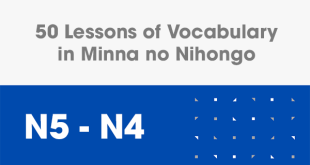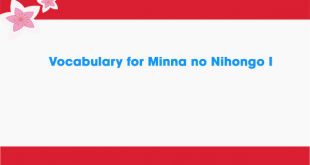Minna No Nihongo Lesson 30 Grammar
1. The verb form て あります
Describe a state arising as a result of whose intentional action
The verb used here is the transitive verb and the verb indicates attention
2. The noun 1 + に + the noun 2 + the verb form て あります
Usage:
This sentence pattern is used to describe in detail how an object exists in its state.
Verbs used in sentences are transitive verbs, verbs that indicate someone’s intention
Example:
カレンダーにこんしゅうのよていがかいてあります
On the calendar that shows the schedule of this week
かべに かがみ をかけて あります
On the wall hangs a mirror
3. The noun 2 は the noun 1 に the verb form て あります
Usage:
Sample this sentence used to describe nouns 2 in structural part 1 is the subject of the sentence
Example:
かがみはかべにかけて あります
The mirror on the wall
こんしゅうのよていはカレンダーにかいてあります
Calendar This week’s work is on the calendar
The sentence pattern is also used to describe something / an action that has already been prepared.。 In this case, or accompanied by [もう]
Example:
かいぎしすの じかんはもうみなさんにしらせてあります
Now the conference announced to everyone then
たんじょうびの プレゼントはもうかってあります
I bought a birthday present (available), then
Note: Distinguish the verb form てあります and the verb form ています:
Verbs used in the form ています mostly is Intransitive Verbs
Verbs used in the form てあります is Transitive Verbs
Example:
ドアをしめる
Doors closed
ドアが しめて あります
Doors (currently) closed. (For a purpose / reason the door is being closed)
ドアが しまて います
door (being) closed. (The condition is currently closed.)
4. The verb form ておき ます
This phrase is used to describe things that were completed before a certain
time.
For example:
かいぎしつのまえになにをしておき ますか
Before the meeting, what should be prepared?
しりょうをコピーしておき ます
Photo available documents
りょこうのまえに ホテルをよやくしておいたら いい です よ
Before traveling, it is recommended to book in advance
Used to handle situations after performing an action or a temporary solution.
For example:
このざっし はぜんぶ よんだら, ひきだしにおしておいて ください
After reading this magazine, leave into the drawer
Used to describe the keep or maintain a certain state
For example:
まどをし めて もいい でか
I closed the window are you?
すみ ません, ちょっとあついです から, その まま あげておいて ください
Please Sorry, it’s a bit hot so please leave it like that
5. ま だ + verb (affirmative)
Meaning: still
Usage: This is a sentence pattern used to describe a state that is still ongoing
For example:
あめは もう やみました か.
Has the rain stopped yet?
いいえ, まだ ふって いまよ.
No, it’s still raining!
6. それ
Usage: Indicates what the conversation partner said earlier
Example:
ブロドウェイでミュージカルみたいといもうんですが
Want to see Broadway musicals
それはいいですね
or it right
Related Post: Minna No Nihongo Lesson 30 Vocabulary
 Learn Japanese Free Learn Japanese Free
Learn Japanese Free Learn Japanese Free







